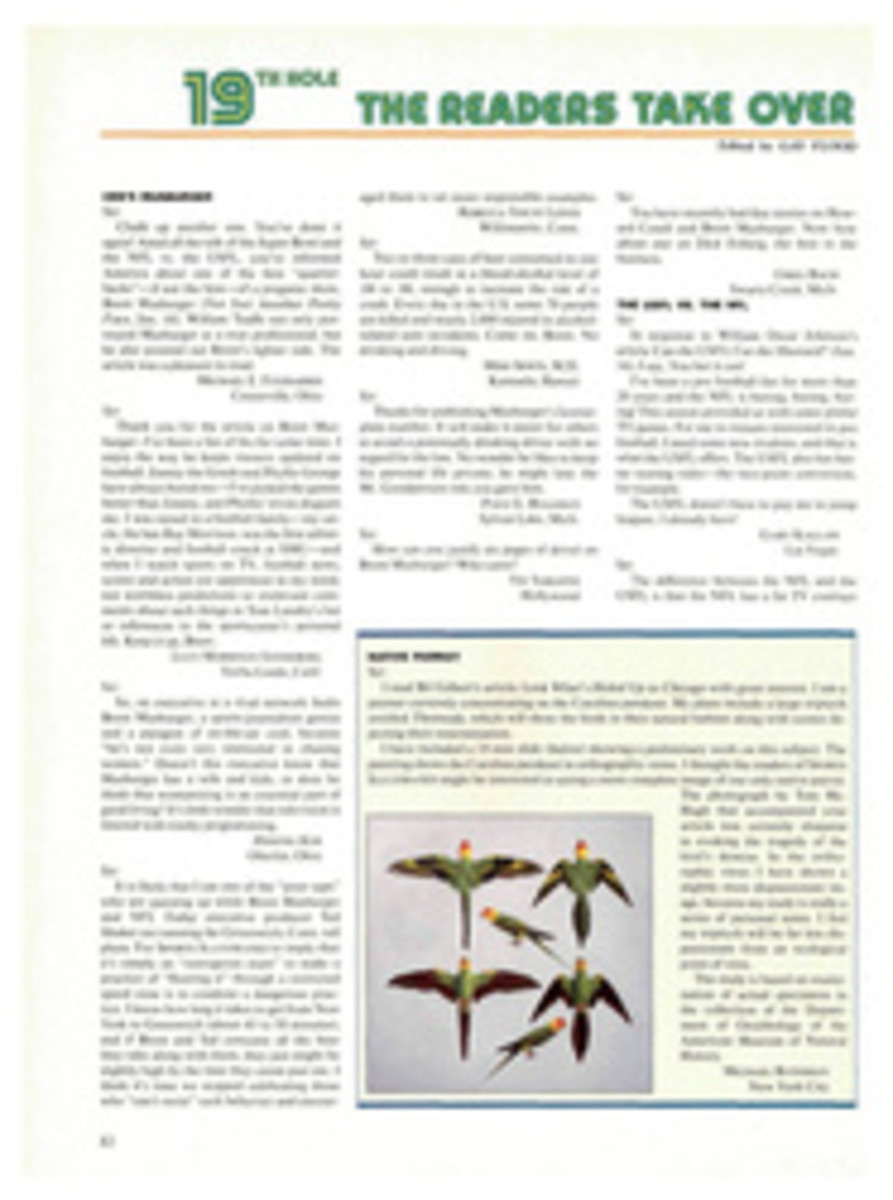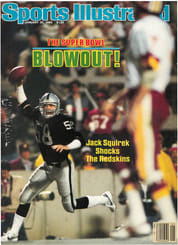
This is no mistake by the lake
Though Cleveland's three long-standing pro teams have been playing lately as if Mistake by the Lake is more motto than malediction, the city nonetheless has the Force with it. And—not at all surprisingly—Cleveland is with the Force.
The Cleveland Force of the MISL has been in existence since 1978, when the city made headlines by going broke. That year, the strange new team in the strange new sport of indoor soccer drew an average of barely 3,000 spectators to spacious Richfield Coliseum (capacity 17,217) and had a 5-19 record. But by 1983 Cleveland had righted itself sufficiently to be selected as one of the nation's 10 Ail-American cities by the National Association of Municipalities, and the Force exemplified that rejuvenation with a 12-1 start and a stirring playoff performance before losing to the Baltimore Blast in the MISL semifinals. There were SRO crowds at Richfield, and TV exposure made players like Keith Furphy and Kai Haaskivi into stars to rival Paul McDonald of the NFL Browns and Andre Thornton of the Indians. With the 1983-84 season nearing its midway point, the Force, at 16-4 through Sunday, had the best record in the 12-team league and was averaging more than 13,000 spectators a game, better than double last year's regular-season attendance. "The Force has filled a void, and the town needs it," says Art Modell, owner and president of the mediocre Browns. "The people of Cleveland want a love affair."
Clevelanders are beginning to view the Browns and Indians as elderly uncles who give the same drab gift every Christmas, while the pathetic NBA Cavaliers are treated like the black sheep of the family. Meanwhile, the Force, with its spectacular player-introduction ceremony emceed by Darth Vader, has become the hottest ticket in town. Case in point: On Dec. 22 a Cavs game with Milwaukee plus a heavily promoted Old Timers' night drew only 4,245 fans to Richfield. The club blamed single-digit temperatures for the poor showing. Four nights later, with the mercury down to-10 and snow falling, 18,621 packed the same building to watch the Force beat Baltimore.
Indoor soccer teams are clobbering their basketball neighbors in other towns as well. The Kansas City Comets—average attendance 15,879—outdraw every NBA club and are killing the Kings, with whom they share Kemper Arena, nearly 2 to 1. The San Diego Sockers of the indoor NASL also are outpulling the NBA Clippers 2 to 1, and the NASL Chicago Sting attracts 3,000 more fans per game at Chicago Stadium than do the NBA Bulls.
Not that the soccer picture is uniformly bright. In each case cited above, the soccer team is a winner and the basketball team a loser. Conversely, crowds for home games of the Lakers, big NBA winners, are better than three times as large as those for the so-so Los Angeles Lazers of the MISL. Moreover, soccer ticket prices are substantially lower than the NBA's, and MISL officials will be happy if five teams make money this year.
"I've never seen a bad sports town, only bad sports and bad owners," says league commissioner Earl Foreman, who has been an owner of the NBA Bullets, the ABA Squires, the NFL Eagles and the outdoor United Soccer League's ill-fated Washington Whips. "We know people will come back to see indoor soccer, but the key is to overcome the inertia that a new sport faces."
Clouding the recognition factor in indoor soccer is the confusing relationship between the MISL and the NASL. The NASL wants to merge the two indoor leagues, thus becoming the only pro soccer major league—and a year-round one—in the U.S. But the MISL, leery of the NASL because of the shakiness of its outdoor, as well as its indoor, circuit, would prefer that the NASL simply dissolve its seven-team indoor league and buy into the MISL at $2 million per franchise. The NASL will have a tough time getting its way. It has successful indoor franchises only in Chicago and San Diego—both of which belonged to the MISL last year. The indoor NASL does have superstars Steve Zungul and Julie Veee in Golden Bay and San Diego, respectively, but the best-known American-born soccer star, Ricky Davis, left the outdoor NASL Cosmos to join the MISL St. Louis Steamers last fall.
Whatever the resolution of the inter-league scuffling, Cleveland would seem to have a secure future. Owner Bert Wolstein and his son, Scott, have created a model franchise in the Force. The elder Wolstein, who made his considerable millions building some 100 K Marts and eight shopping malls, took over the Force in 1979, looking to put some excitement and challenge back into his life. He has also put $5.5 million into the team. "I'm still just a big boy, a kid," says Wolstein, trim and eagle-eyed at age 56. "I don't want to spend my time seeing how many more buildings I can put up."
"We really can't lose in real estate anymore," adds Scott, a 31-year-old tax attorney who handles the Force's player negotiations. "We know our business too well. The fear of losing is gone, and fear is the strongest human emotion. Sports puts fear of losing in the forefront every single day."
In the early going, the Wolsteins found receiving their daily dosage of fear was no problem. "We didn't know what we were doing," says Bert. "Our first year we had a game on a Saturday afternoon instead of at night and wondered why only 1,200 people showed up. I mean, what the hell did we know?"
The Wolsteins decided in 1983 to devote more than 90% of their business time to the Force. Progress was slow in coming, but a key step toward building a winner came in 1982, when they hired Timo Liekoski, who had been a Coach of the Year in both the NASL and the MISL. While some teams in both leagues have tried to attract fans by loading up on American-born talent, Liekoski has resisted that trend—only 11 of the 26 players on the Force's roster are U.S. natives, compared with the league-wide figure of 52%. Liekoski has emphasized depth and a relentless style that wears down thinner squads.
The main men in executing Liekoski's nonstop tactics are midfielder Haaskivi, a 28-year-old Finn whose leadership under fire is reminiscent of that of his off-season friend Wayne Gretzky, and the 25-year-old Furphy, the Force's second-leading scorer through Sunday with 21 goals and 18 assists. Furphy, a forward, is a 6'2" Englishman who gets out on the break with the fury and grace of a Bernard King. He also knows a little about marketing; he's the host of a local weekly television show, the model on a hot-selling poster and the author of a soccer instruction book. All of which augments a salary in the high five-figure range. That's big money in the MISL. And the reasonable salary structure is one more reason for the league's potential for success. "The whole idea is to bring the game to the people and do well for myself at the same time," says Furphy, who has been a pro since the age of 14.
The Force's payroll is one of the highest in the league, and in exchange for his money, Bert Wolstein expects the players to promote the club at all manner of events. They appear at youth clinics and model at fashion shows. "We want our players to be so accessible in the community, so visible, that an emotional attachment is genuine," says Scott.
K.C.'s Comets have used an aggressive marketing scheme to sell a losing team as a collection of sex symbols. But even Comet president J. Tracey Leiweke concedes that the Force's approach is better for the sport. Says Leiweke, "The Wolsteins have done it without a lot of razzle-dazzle by simply building a strong team in a city that hasn't had a winner and letting the sport speak for itself."
And the Force has spoken.
PHOTO
Louie Nanchoff did some Forceful footwork in a 9-7 Cleveland win over Kansas City.
TWO PHOTOS
An earthbound Darth Vader is merely the Force's front man. K Mart magnate Wolstein is the driving force behind the team.

